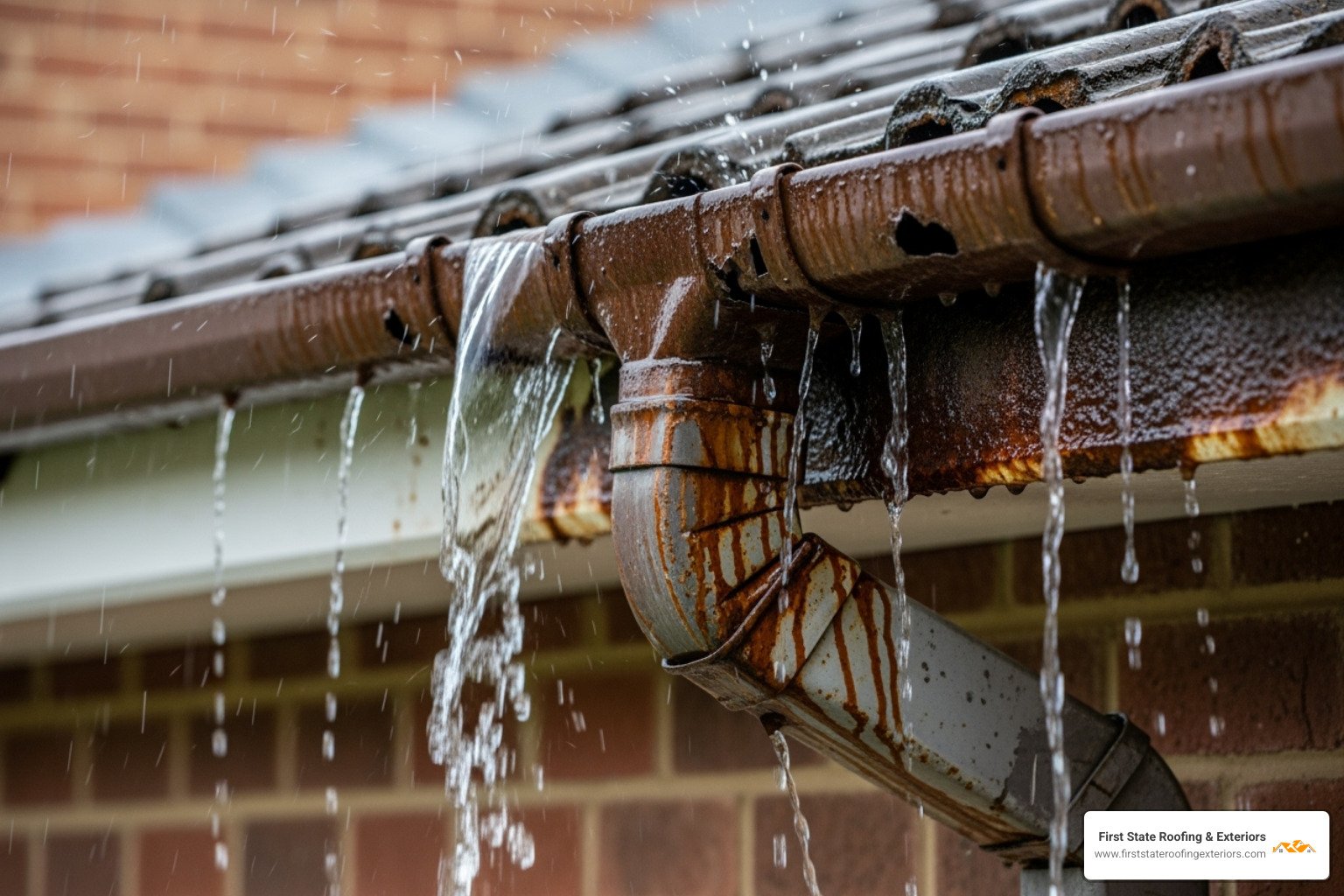Why Ignoring Gutter Problems Could Cost You Thousands
Gutter and downpipe repairs are among the most critical yet overlooked maintenance tasks for Delaware homeowners. A failing drainage system can lead to foundation damage, wood rot, and pest infestations, resulting in thousands of dollars in repairs. For comprehensive roofing and exterior services that protect your home, addressing gutter issues early is essential.
Quick fixes for common gutter issues:
- Small cracks/holes: Use waterproof sealant or repair tape.
- Leaking joints: Clean and reseal the joint.
- Sagging sections: Re-secure brackets and check the pitch.
- Blocked downpipes: Clear debris and install leaf guards.
- Extensive damage: Consider full replacement.
- When to call pros: For structural damage or hard-to-reach areas.
Neglected plumbing, including broken downpipes, is a leading cause of property water damage. A minor drip can escalate quickly, pooling around your foundation or seeping into your home’s structure. I’m Richard McCain, owner of First State Roofing & Exteriors. With over 20 years of experience in Delaware, I’ve seen how timely gutter and downpipe repairs protect a homeowner’s most valuable investment.

Terms related to gutter and downpipe repairs:
Spotting the Red Flags: Signs You Need Gutter or Downpipe Repair
Your home provides clues when your drainage system is failing. Recognizing these early signs of needed gutter or downpipe repair can prevent minor issues from becoming major headaches.
Water Stains and Peeling Paint
Visible water stains on exterior walls or peeling paint below the gutter line are clear signs of overflow. Inside, look for damp spots on ceilings or walls near the roofline, which indicate water is seeping into your home’s structure.
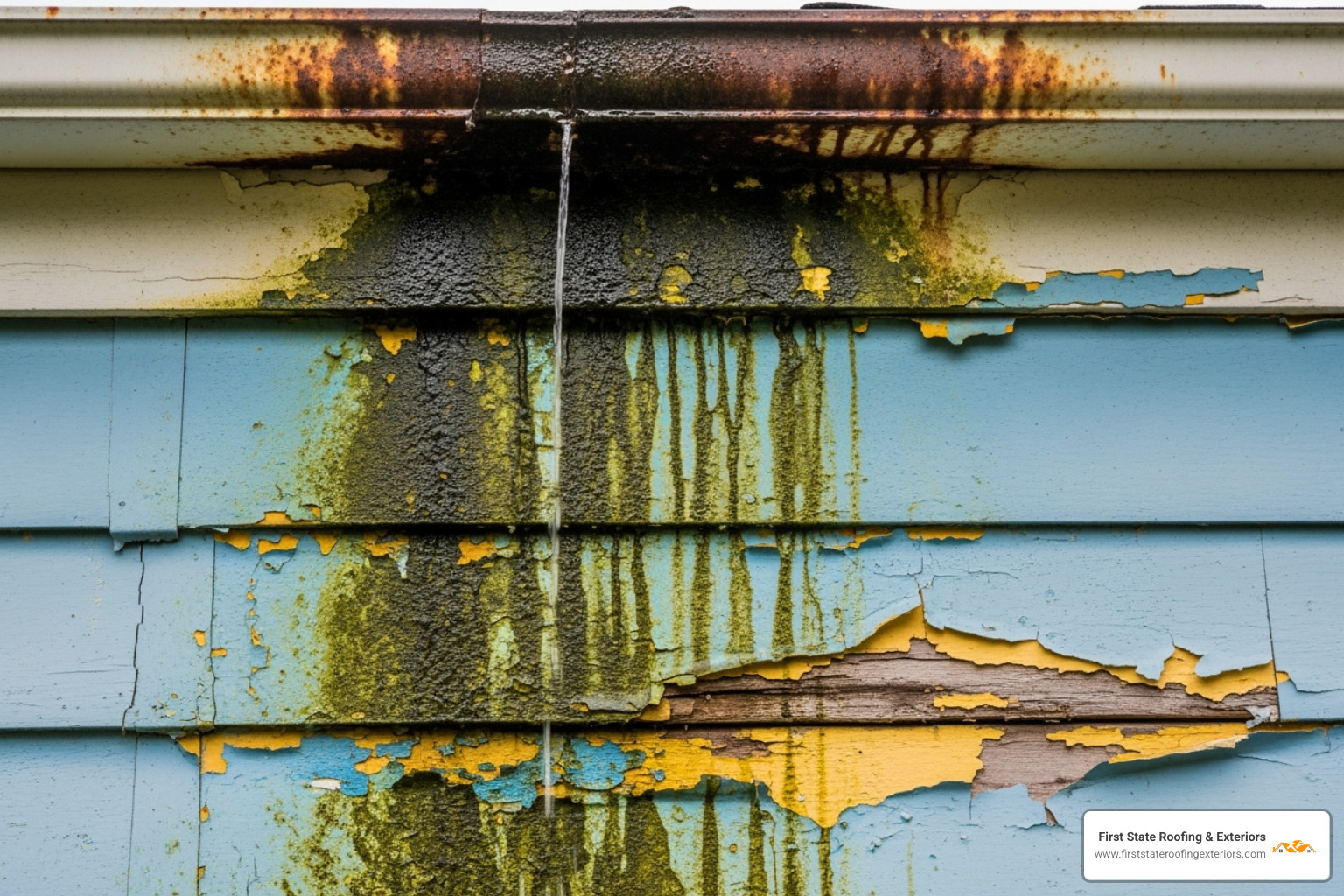
Sagging, Pulling Away, or Misaligned Gutters
Gutters should have a slight pitch toward the downpipes. If you see sagging or sections pulling away from the fascia board, it’s often due to the weight of clogs and standing water. This strain on fasteners can cause misalignment, leading to overflow. For more details, see our guide on sagging gutter repair.
Cracks, Holes, and Rust Spots
Inspect your gutters for physical damage like cracks, holes, or rust. Metal gutters can corrode over time, while plastic gutters can become brittle from UV exposure and crack. Even a small opening can cause significant water leakage, inviting pests and wood rot.
Water Pooling Around Your Foundation
Water pooling near your foundation is a critical red flag. It means your downpipes are blocked or damaged and aren’t directing water away from your home. This can lead to foundation erosion, structural issues, and basement flooding, undermining your home’s integrity. Regular inspection of your exterior, including siding, is key. Learn more with our tips on siding and gutter maintenance.
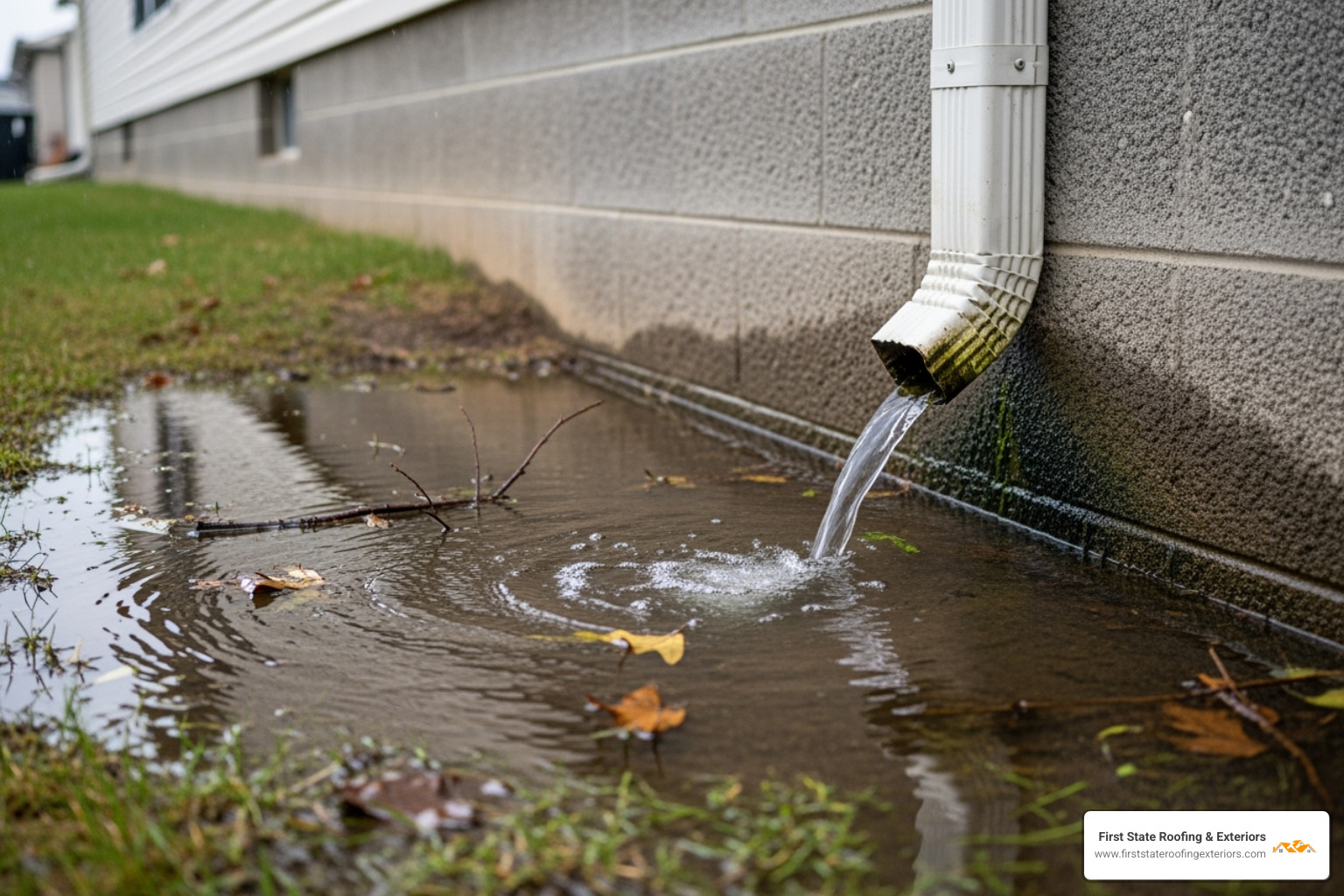
The Root of the Problem: Common Causes of Gutter and Downpipe Damage
Understanding why gutter and downpipe repairs become necessary helps you prevent them. The issues are often a combination of environmental factors and material aging.
- Debris Buildup: Leaves, twigs, and shingle grit are the primary culprits. This organic matter creates blockages, causing water to back up, overflow, and strain the entire system.
- Weather and Temperature: Delaware’s heavy rains, hail, and winter ice dams can weigh down, damage, or tear gutters from your home. The constant expansion and contraction from temperature fluctuations also stress seams, leading to cracks, especially in vinyl systems.
- Improper Installation: Gutters installed without the correct pitch will cause water to pool. Misaligned downpipes create leaks. These errors are common in older homes or after DIY projects.
- Normal Wear and Tear: Over time, UV rays and constant moisture cause materials to fatigue. Metal can corrode, and plastic becomes brittle.
Staying ahead of these root causes is key to avoiding expensive problems. For more prevention strategies, FEMA offers valuable information on water damage prevention.
Repair vs. Replace: Making the Right Choice for Your Home
When facing gutter issues, the big question is whether to repair or replace. The cheaper upfront option isn’t always the most cost-effective in the long run. After two decades of gutter and downpipe repairs in Delaware, I’ve seen that temporary patches can lead to recurring problems.
| Factor | Repair | Replacement |
|---|---|---|
| Upfront Cost | Lower | Higher |
| Long-Term Cost | Can be higher with frequent fixes | Lower with proper maintenance |
| Lifespan | Temporary fix | Extends system lifespan significantly |
| Material Condition | Best for isolated damage | Best for widespread degradation |
| Best Use Case | Minor leaks, small cracks | Old, failing, or non-compliant systems |
Hidden costs like labor and equipment can make even simple repairs surprisingly expensive, especially if they fail and need to be redone. For a clearer financial picture, review our guide on gutter repair costs.
When to Choose Repair
A repair is a great choice for minor, isolated issues in an otherwise healthy system. This includes a small crack, a single leaking joint, or a loose section on a recently installed system. If the surrounding material is still strong, a targeted fix can provide years of service.
When Replacement is the Only Smart Option
Replacement is the smart move when you’re facing extensive, recurring problems.
- Widespread Damage: If you have widespread rust, corrosion, or multiple cracks, your gutters have reached the end of their life.
- Old, Brittle Plastic: Old plastic gutters are a common issue. They become brittle, and new fittings rarely seal properly with the weathered material, causing repairs to fail quickly.
- Persistent Leaks: If you’ve tried multiple repairs and problems keep returning, your system is telling you it’s time for an upgrade.
Investing in a full replacement means your money goes toward a lasting solution, not a temporary patch. Explore our gutter installation services for a long-term system that will protect your home for decades.
A Homeowner’s Guide to Gutter and Downpipe Repairs
While some gutter and downpipe repairs require a professional, you can tackle minor issues yourself if you prioritize safety.
Always wear sturdy, non-slip shoes, heavy-duty gloves, and eye protection. Use a stable ladder on level ground and never work alone. It’s crucial not to overreach; it’s safer to climb down and move the ladder. If you’re uncomfortable with heights, call a professional. No repair is worth risking your safety.
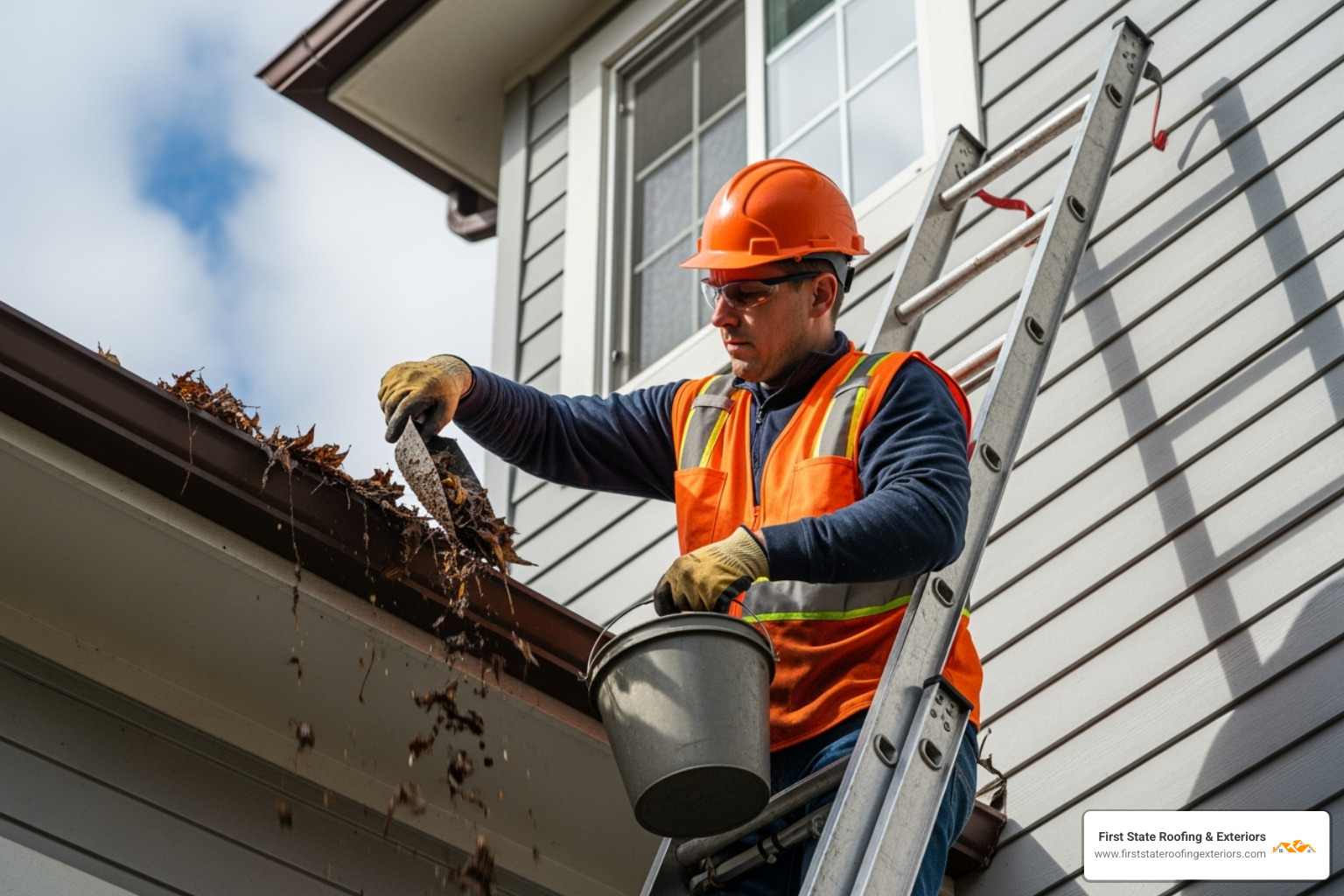
Step-by-Step DIY Gutter and Downpipe Repairs for Minor Issues
For manageable leaks or blockages, a DIY approach can work. First, gather your tools: a ladder, gloves, a bucket, a trowel, a hose, and waterproof gutter sealant.
- Clean the Area: Remove all debris from the gutter and flush it with a hose. The area must be completely clean and dry before applying sealant.
- Seal Small Cracks/Holes: Apply waterproof gutter sealant generously over the damaged area, covering both inside and outside surfaces.
- Fix Leaking Joints: Unclip the gutter from the union joint, clean the gasket and gutter ends, and replace the union fitting if the gasket is worn. Apply a bead of sealant for extra protection.
- Tighten Loose Fittings: Check all hangers and fasteners. Tighten loose screws and replace any that are broken.
- Test Your Work: Run water through the repaired section with a hose to check for any remaining drips.
When to Call a Professional for Gutter and Downpipe Repairs
As a Delaware company, we know when a professional touch is essential. Call for help in these situations:
- Hard-to-reach areas: Second-story gutters require specialized safety equipment.
- Suspected structural damage: If you see rot on fascia boards or soffits, you need a professional assessment.
- Extensive repairs: Widespread rust or multiple large cracks are best left to experienced pros.
- Lack of tools or experience: A professional ensures the job is done right the first time, saving you money in the long run.
- Persistent leaks: If your DIY repairs fail, there’s likely an underlying issue that needs an expert diagnosis.
For lasting results, our professional gutter repair services are designed to protect your home for years.
Choosing the Best Materials: Aluminum vs. Plastic
When it comes to gutter and downpipe repairs or replacement, your choice of material is crucial. It affects durability, cost, and appearance. In our two decades of experience in Delaware, we’ve found a clear winner between the two most common options: aluminum and plastic.
The Long-Lasting Value of Aluminum
Aluminum is a superior long-term investment. Here’s why:
- Durability: With proper maintenance, aluminum gutters can last up to 60 years.
- Rust-Proof: Unlike steel, aluminum won’t rust, preventing stains on your siding.
- Resilience: It resists becoming brittle and cracking through decades of temperature swings.
- Fewer Leaks: Seamless aluminum systems have fewer joints, which are the most common points of failure.
- Eco-Friendly: Aluminum is 100% recyclable at the end of its long life.
- Aesthetics: It comes in a wide range of factory-finished colors that resist fading.
The Pitfalls of Plastic (Vinyl) Gutters
Plastic gutters may seem like a budget-friendly choice, but they often cost more in the long run.
- Brittleness: Plastic becomes extremely brittle with age and UV exposure, cracking easily from impacts or even the weight of wet leaves.
- Fading: The color will fade and become chalky after a few years in the sun.
- Failed Repairs: Gasket seals fail over time, and new plastic fittings rarely create a proper seal with old, sun-hardened guttering. Repairs are often temporary and frustrating.
When plastic gutters start to fail, replacement with a durable aluminum system is almost always the most cost-effective solution. The initial investment pays for itself through decades of reliable performance.
Finding the Right Partner: How to Choose a Gutter Service Company
Finding the right company for gutter and downpipe repairs means finding a partner you can trust to protect your home. After two decades in this business, I’ve seen the difference a reliable, local expert makes.
Here’s what to look for in a gutter service company:
- Local Expertise: A company rooted in Delaware understands our local weather and how it affects your home. They know which materials stand up to our coastal climate and what common issues to look for.
- Licensing and Insurance: Never hire a contractor who can’t provide proof of current licensing and comprehensive insurance. This protects you and your property.
- Workmanship Warranty: A reputable company stands behind its work with a solid warranty. This is your guarantee that they’ll make things right if issues arise.
- Customer Reviews: Read recent reviews to see how a company handles its projects and communicates with clients. Look for patterns in feedback.
- Transparent Pricing: Insist on a detailed, written estimate with no hidden fees. You should know exactly what you’re paying for.
- Experience: An experienced team can spot potential problems before they become expensive disasters and recommend solutions that fit your budget. For example, our experience with comprehensive roofing services in Smyrna gives us unique insight into that area’s needs.
You want a company that treats your home like their own and is available when you need them. We’re here 24/7 because water damage doesn’t keep business hours.
Embracing Modern Standards: What Delaware Homeowners Should Know
Building codes and best practices for drainage systems evolve to better protect homes from water damage. What worked for gutter and downpipe repairs decades ago may not be sufficient for Delaware’s modern weather patterns.
- Overflow Protection: Older gutters often lack overflow cut-outs or proper spacing from the fascia. During heavy rain, water spills down the back, rotting the wood. Modern installations include a protective gap and overflow holes that direct excess water away from your home’s structure.
- Adequate Downpipes: Many older homes lack enough downpipes to handle heavy downpours, leading to overflow and damage. We often recommend upsizing or adding downpipes to improve water evacuation. You can never have too many.
- Correct Pitch: Gutters must be pitched correctly to allow water to flow to the downspouts. Even a slight sag can cause pooling, leaks, and damage. Re-pitching a section is a job for professionals.
- Material Compatibility: Matching new parts to outdated gutter profiles can be impossible. This often means a simple repair becomes a full replacement—an opportunity to upgrade to a modern system that meets today’s higher standards.
When we install new guttering, we ensure it complies with current best practices to give your home the best possible protection against water damage.
The Hidden Dangers: Consequences of Neglecting Gutter and Downpipe Maintenance
The “minor” gutter issues you ignore can quickly become expensive disasters. In our two decades serving Delaware, we’ve seen how a small drip can snowball into thousands of dollars in damage. Most of these problems are preventable with timely gutter and downpipe repairs.
Here are the hidden dangers of neglect:
- Foundation Damage: This is the costliest consequence. When gutters overflow, water pools around your foundation, creating pressure that leads to cracks, shifting, and serious structural issues.
- Basement Flooding and Mold: Water seeping into your basement can destroy property and create a breeding ground for mold and mildew, which pose health risks and require expensive remediation.
- Wood Rot and Pest Infestations: Constant moisture from overflowing gutters rots fascia boards, soffits, and roof decking. This damp, decaying wood attracts termites, rodents, and other pests.
- Exterior and Landscape Damage: Uncontrolled water spillage stains siding, peels paint, and damages windows. It can also cause landscape erosion, washing away topsoil and ruining flowerbeds.
Delaying essential gutter and downpipe repairs is a gamble with your home’s safety and your finances. The good news is that these issues are avoidable with proactive maintenance.
Proactive Protection: Regular Maintenance for a Healthy Home
The best way to avoid expensive gutter and downpipe repairs is through proactive maintenance. A little preventive care can save you from major headaches.
- Regular Cleaning: Clean your gutters at least twice a year—in late spring and late autumn. If you have many trees, you may need to clean them more often to remove leaves, twigs, and shingle grit before they cause blockages.
- Seasonal Inspections: Each season, walk around your home and visually inspect your gutters. Look for rust, cracks, sagging sections, or any signs of damage.
- Install Gutter Guards: These protective covers are a smart investment. They significantly reduce the amount of debris entering your gutters, which means fewer cleanings and a lower risk of clogs.
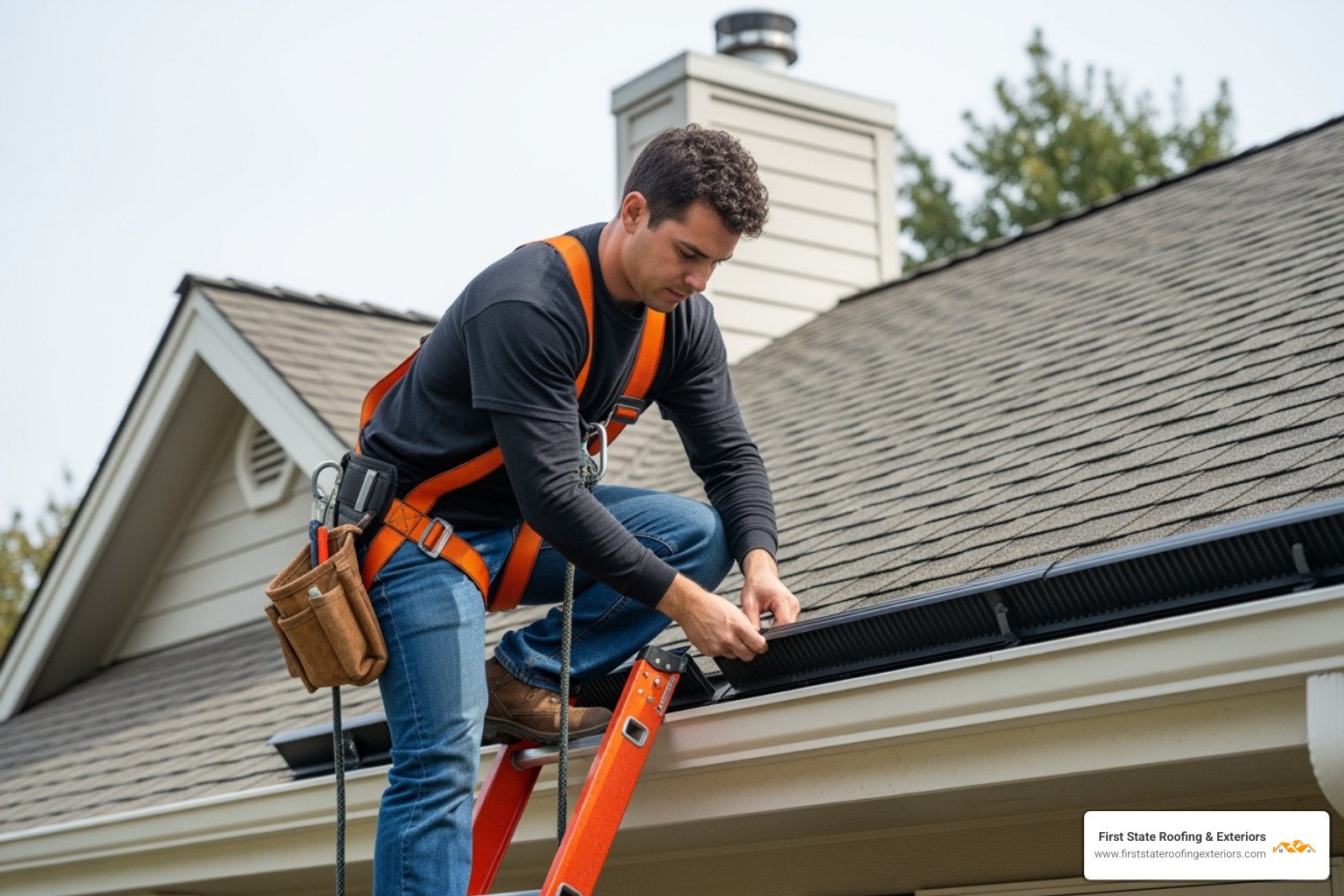
- Proper Professional Installation: When you need new gutters, having them installed correctly by professionals prevents future problems like improper pitch or loose fasteners.
- Annual Professional Inspections: A yearly checkup from a specialist can spot subtle issues you might miss, like hidden blockages or early signs of fascia damage.
Following these practices protects your entire home investment by ensuring your drainage system works efficiently for decades.
Conclusion
Your gutters and downpipes are your home’s first line of defense against water damage. Neglecting gutter and downpipe repairs is like leaving a hole in your roof during a storm—the consequences can be devastating.
This guide has shown you the warning signs to watch for, how to decide between repair and replacement, and how proactive maintenance can protect your investment. At First State Roofing & Exteriors, we’ve seen how a small leak can lead to major structural damage. As your local Delaware experts, we understand our climate’s challenges and recommend durable aluminum systems with modern overflow protection to keep your home safe.
Don’t let minor gutter issues become major disasters. Whether you have persistent leaks, sagging sections, or an aging system, early action saves money and stress. First State Roofing & Exteriors gives free estimates. For a free inspection for your gutter and downpipe needs in Delaware, call us today at (302) 222-4065. We’re available 24/7, and our emergency roof repair services ensure you’re never left to deal with water damage alone.
